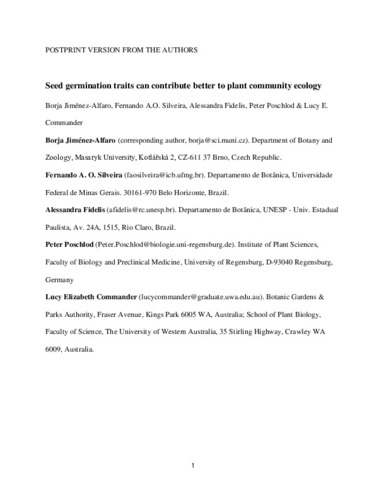Seed germination traits can contribute better to community ecology
Palabra(s) clave:
Community assembly
Climate change
Dispersal
Plant functional traits
Regeneration niche
Restoration ecology
Seed germination
Seed morphology
Seed traits
Fecha de publicación:
Versión del editor:
Citación:
Descripción física:
Resumen:
Analyses of functional traits have become fundamental tools for understanding patterns and processes in plant community ecology. In this context, regenerative seed traits play an important, yet overlooked role, because they largely determine the ability of plants to disperse and re-establish. A survey of recent publications in community ecology suggests that seed germination traits in particular are neglected at the expense of other relevant but overused traits based only on seed morphology. As a response to this bias, we discuss the functional significance of seed germination traits in comparison with morphological and biophysical seed traits, and advocate for their use in vegetation science. We also demonstrate how research in community assembly, climate change and restoration ecology can benefit from the inclusion of germination traits, encompassing functions that cannot be explained solely by adult plant traits. Seed germination experiments conducted in the laboratory or field to quantify these traits provide ecologically meaningful and relatively easy-to--obtain information about the functional properties of plant communities. We argue that bridging the gap between seed physiologists and community ecologists will improve the prediction of plant assemblages, and propose further perspectives for including seed traits into the research agenda of functional community ecologists.
Analyses of functional traits have become fundamental tools for understanding patterns and processes in plant community ecology. In this context, regenerative seed traits play an important, yet overlooked role, because they largely determine the ability of plants to disperse and re-establish. A survey of recent publications in community ecology suggests that seed germination traits in particular are neglected at the expense of other relevant but overused traits based only on seed morphology. As a response to this bias, we discuss the functional significance of seed germination traits in comparison with morphological and biophysical seed traits, and advocate for their use in vegetation science. We also demonstrate how research in community assembly, climate change and restoration ecology can benefit from the inclusion of germination traits, encompassing functions that cannot be explained solely by adult plant traits. Seed germination experiments conducted in the laboratory or field to quantify these traits provide ecologically meaningful and relatively easy-to--obtain information about the functional properties of plant communities. We argue that bridging the gap between seed physiologists and community ecologists will improve the prediction of plant assemblages, and propose further perspectives for including seed traits into the research agenda of functional community ecologists.
ISSN:
DOI:
Colecciones
Ficheros en el ítem





